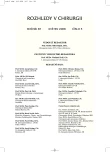Treatment of Thrombotic Complications of Surgical Infrainguinal Revascularizations
Authors:
P. Šeliga 1; J. Vaško 1; P. Kováč 1; M. Šimko 2
Authors‘ workplace:
Oddelenie cievnej chirurgie FNsP Prešov, Slovenská republika, primár: MUDr. J. Vaško
1; Oddelenie rádiodiagnostiky FNsP Prešov, Slovenská republika, primár: MUDr. M. Šimko
2
Published in:
Rozhl. Chir., 2008, roč. 87, č. 5, s. 268-273.
Category:
Monothematic special - Original
Overview
Aim:
Authors in the work analyse the patients hospitalized with thrombosis of the surgical infrainguinal reconstruction. They evaluate the causes of reconstructions occlusions, therapeutic options in the treatment and their experiences with treatment of these patients.
Method:
It is the retrospective analysis of the patients hospitalized during years 2001–2006 at the Department of Vascular Surgery of the Teaching Hospital J. A. Reimana in Prešov with thrombosis of the surgical infrainguinal reconstruction. During the study period 723 surgical infrainguinal revascularization procedures were performed. The basic therapeutic approach in the care of these patients is anticoagulation and digital subtraction angiography, then they decide between percutaneous endovascular treatment, surgical thrombectomy, reoperation with implantation of the new reconstruction or conservative treatment. In the phase of irreversible ischemia high amputation is indicated.
Results:
Thrombosis of the reconstruction was occured in 109 subjects (15.8%). Prothesis was thrombosed in 71 subjects (65.14%), vein in 38 subjects (34.86%). Percutaneous endovascular treatment was indicated in 3 subjects (2.8%), surgical thrombectomy with correction of the stenosis in 23 subjects (21.1%), reoperation with implantation of the new reconstruction in 53 subjects (48.6%), conservative approach in 21 subjects (19.3%), high amputation in 9 subjects (8.2%). The secondary patency after 12 months according to the life table method analysis after percutaneous endovascular treatment was 75%, after surgical thrombectomy of the graft with correction of stenosis 37% and after reoperation with implantation of the new reconstruction 72%.
Conclusion:
Authors believe that the best treatment in the care of the patients with thrombosis of the surgical infrainguinal reconstruction and critical limb ischemia is implantation of the new secondary reconstruction with autologous vein.
Key words:
infrainguinal bypass – graft occlusion – risk factors for graft occlusion
Sources
1. Ariesen, M. J., Tangelder, M. J. D., Lawson, J. A., Eikelboom, B. C., Grobbee, D. E., Algra, A. Risk of major haemorrhage in patients after infrainguinal venous bypass surgery: Therapeutic consequences? The Dutch BOA (Bypass Oral Anticoagulants or Aspirin) Study. Europen Journal of Vascular and Endovascular surgery, 2005, č. 30, s. 154–159.
2. Ascer, E., Collier, P., Gupta, S. K., Veith, F. J. Reoperation for polytetrafluoroethylene bypass failure: The importance of distal outflow site and operative technique in determining outcome. Journal of Vascular Surgery, 1987, č. 5, s. 298–310.
3. Belkin, M., Conte, M. S., Donaldson, M. C., Mannick, J. A., Whittemore, A. D. Preffered strategies for secondary infrainguinal bypass: Lessons learned from 300 consecutive reoperations. Journal of Vascular Surgery, 1995, č. 21, s. 282–295.
4. Boroňová, I., Bernasovský, I., Bernasovská, J. Detection of Philadelphia chromozome in patients with chronic myeloid leukemia from the Prešov region in Slovakia (1995–2004). International Journal of Human Genetics, 2007, č.7 (4), s. 297–301.
5. Dalman, R. L. Expected outcome: Early results, life table patency, limb salvage. In: Mills, J. L., et al.: Management of chronic lower limb ischemia. London: Arnold; 2000, s. 106–112.
6. Gibson, K. D., Caps, M. T., Gillen, D., Bergelin, R. O., Primozich, J., Strandness, D. E. Identification of factors predictive of lower extremity vein graft thrombosis. Journal of Vascular Surgery, 2001, č. 33, s. 24–31.
7. Mýtnik, M., Kyslan, K. Zásady úspešnej prevencie ranej infekcie v chirurgii. Slovenská chirurgia, 2004, č. 1, s. 26–28.
8. Nehler, M. R., Mueller, R. J., McLafferty, R. B., Johnson, S. P., Nussbaum, J. D., Mattos, M. A., Whitehill, T. A., Esler, A. L. Outcome of catheter-directed thrombolysis for lower extremity arterial bypass occlusion. Journal of Vascular Surgery, 2003, č. 37, s. 72–78.
9. Šefránek V., Hricák, V., Mazuch, J., Tomka, J., Záhorec, R. Ochorenia končatinových artérií a ich chirurgická liečba. Bratislava: SAP; 2001, 240 s. ISBN 80-88908-82-5.
10. Tangelder, M. J. D., Algra, A., Lawson, J. A., Eikelboom, B. C. Risk factors for occlusion of infrainguinal bypass grafts. European Journal of Vascular and Endovascular Surgery, 2000, č. 20, s. 118–124.
11. Taylor, L. M., Landry, G. J., Moneta, G. L. An approach to treatment of infrainguinal graft occlusions. In: Towne, J. B., Hollier, L. R., et al.: Complications in vascular surgery. New York: Marcel Dekker, Inc.; 2004, s. 355–364. ISBN 0-8247-4776-3.
12. Veith, F. J., Lipsitz, E. C., Gargiulo, N. J., Ascher, E. Secondary arterial reconstructions in the lower extremity. In: Rutherford, R. B. et al.: Vascular surgery. Philadelphia: Elsevier Saunders; 2005, s. 1181–1191.
Labels
Surgery Orthopaedics Trauma surgeryArticle was published in
Perspectives in Surgery

2008 Issue 5
Most read in this issue
- Superior Mesenteric Artery (SMAS/AMS) Syndrome and its Management
- Primary Retroperitoneal Tumor – Extraadrenal Paraganglioma – A Case Review
- Functional Changes in the Cardioesophageal Region Following Laparoscopic Fundoplication
- Elective Videothoracoscopy – A Tool for Prevention of Primary Spontaneous Pneumothorax?
